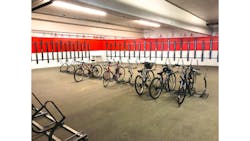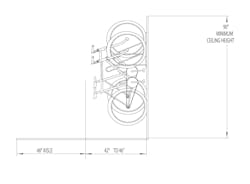Properly spacing bike storage racks is essential for functionality, safety, and design efficiency. For architects, integrating bike storage requires a balance between maximizing capacity and ensuring accessibility. A well-planned bike storage area enhances usability, promotes sustainable transportation, and adds value to a building's design. This guide provides best practices, common mistakes to avoid, and industry standards to follow when planning bike storage solutions.
Industry Standards and Spacing Guidelines
Bike storage should be planned with clear spacing requirements to ensure ease of use and compliance with accessibility guidelines. Following best practices allows for efficient storage without compromising functionality. Here are key industry standards to consider:
- Aisle Space: A minimum of 48 inches of aisle clearance is recommended for maneuverability. This is the space between rows after bikes would be parked. This helps ensure users can comfortably enter and exit the storage area without obstruction.
- Vertical Clearance: Ensure at least 90 inches from the floor to accommodate both vertical bike storage racks & two-tier bike storage systems. This extra space prevents conflicts with ceiling structures and allows for easy lifting of bicycles.
- ADA Compliance: Provide clearance between each ground rack of at least 36 inches (48 inches recommended), and aisle spacing as mentioned above.
Optimizing Space: Ground vs. Vertical vs. Two-Tier Horizontal Racks
When planning bike storage, selecting the right type of rack is crucial. Ground, Vertical, and Horizontal racks offer different benefits depending on the available space. Architects should consider potential user physical limitations, convenience, ceiling height, and overall space constraints when deciding on the best approach.
- Ground Bike Racks: Floor mounted racks should be placed a minimum of 36 inches from the wall (or a minimum of 24 inches).
- Vertical Bike Racks: If mounted at the same height, vertical bike storage racks should be 24 inches apart, but staggering allows for just 15 inches needed between them, increasing stalls in the space & avoids handlebar conflicts. They do require a 90” ceiling clearance and work well in offices, apartments, and high-density urban areas.
- Horizontal/Two-Tier Racks: Two-tier bike storage racks maximize capacity while saving space, making them ideal for public bike parking and high-density areas. Some models require lifting to access the top tier, while lift-assist bike storage options make loading easier. These systems are a great solution for large-scale storage.
Common Mistakes to Avoid
Even well-designed bike storage areas can fail due to improper spacing or layout issues. Avoiding common mistakes ensures that bike storage remains functional and easy to use. Here are some key pitfalls to watch out for:
- Overcrowding Racks: Placing racks too close together reduces usability, increases frustration, and leads to potential damage.
- Lack of Wayfinding & Signage: Clear labeling helps users quickly locate storage areas and understand how to properly secure their bikes.
- Neglecting Security Considerations: Incorporating surveillance and secure entry points enhances protection and prevents theft.
Best Practices for Bike Storage Layouts
To optimize bike storage within different interior spaces, follow these layout strategies:
- Provide a mix of vertical and horizontal racks to cater to different user preferences and abilities.
- Ensure proper lighting and security features to enhance safety and usability, particularly in enclosed spaces.
- Plan for future growth by designing adaptable bike storage solutions that can expand with demand.
- Consider ventilation and drainage in enclosed bike rooms to prevent moisture buildup and maintain equipment integrity.
- Incorporate user-friendly access points such as sliding doors or ramps to make bike storage more accessible.
Designing for Different Building Types
The ideal bike storage solution varies depending on the type of building. Here’s how you can tailor designs:
- Residential Complexes: Mixed storage solutions (vertical, horizontal, and ground level racks) ensure ease of access for all residents.
- Retail & Public Spaces: Highly visible bike parking areas with wayfinding signage encourage cycling and enhance urban connectivity.
- Transit Hubs & Universities: High-density storage solutions, such as two-tier racks accommodate large volumes of cyclists efficiently.
Conclusion & Key Takeaways
Correctly spacing bike racks improves usability, safety, and efficiency in any space. By following these guidelines, you can create functional, user-friendly bike storage solutions that enhance the overall building experience.
Implementing well designed bike storage encourages sustainable transportation, improves space efficiency, and adds long term value to properties.
For expert recommendations, high quality bike storage products, and further insights, contact Madrax Bike Racks.


